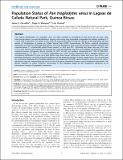Files in this item
Population status of Pan troglodytes verus in Lagoas de Cufada Natural Park, Guinea-Bissau
Item metadata
| dc.contributor.author | Carvalho, Joana S. | |
| dc.contributor.author | Marques, Tiago A. | |
| dc.contributor.author | Vicente, Luis | |
| dc.date.accessioned | 2013-08-21T13:31:01Z | |
| dc.date.available | 2013-08-21T13:31:01Z | |
| dc.date.issued | 2013-08 | |
| dc.identifier | 66181441 | |
| dc.identifier | 58483f1e-567b-44e8-b5d1-cefa11905ea1 | |
| dc.identifier | 84881327176 | |
| dc.identifier.citation | Carvalho , J S , Marques , T A & Vicente , L 2013 , ' Population status of Pan troglodytes verus in Lagoas de Cufada Natural Park, Guinea-Bissau ' , PLoS One , vol. 8 , no. 8 , e71527 . https://doi.org/10.1371/journal.pone.0071527 | en |
| dc.identifier.issn | 1932-6203 | |
| dc.identifier.other | ORCID: /0000-0002-2581-1972/work/56861291 | |
| dc.identifier.uri | https://hdl.handle.net/10023/3974 | |
| dc.description.abstract | The western chimpanzee, Pan troglodytes verus, has been classified as Endangered on the IUCN Red List since 1988. Intensive agriculture, commercial plantations, logging, and mining have eliminated or degraded the habitats suitable for P. t. verus over a large part of its range. In this study we assessed the effect of land-use change on the population size and density of chimpanzees at Lagoas de Cufada Natural Park (LCNP), Guinea-Bissau. We further explored chimpanzee distribution in relation to landscape-level proxies of human disturbance. Nest count and distance-sampling methods were employed along 11 systematically placed linear transects in 2010 and 2011. Estimated nest decay rate was 293.9 days (%CV = 58.8). Based on this estimate of decay time and using the Standing-Crop Nest Count Method, we obtained a habitat-weighted average chimpanzee density estimate for 2011 of 0.22 nest building chimpanzees/km2 (95% CI 0.08–0.62), corresponding to 137 (95% CI 51.0–390.0) chimpanzees for LCNP. Human disturbance had a negative influence on chimpanzee distribution as nests were built farther away from human settlements, roads, and rivers than if they were randomly distributed, coinciding with the distribution of the remaining patches of dense canopy forest. We conclude that the continuous disappearance of suitable habitat (e.g. the replacement of LCNP's dense forests by monocultures of cashew plantations) may be compromising the future of one of the most threatened Guinean coastal chimpanzee populations. We discuss strategies to ensure long-term conservation in this important refuge for this chimpanzee subspecies at its westernmost margin of geographic distribution. | |
| dc.format.extent | 595512 | |
| dc.language.iso | eng | |
| dc.relation.ispartof | PLoS One | en |
| dc.subject | Western chimpanzee | en |
| dc.subject | Pan troglodytes verus | en |
| dc.subject | Endangered species | en |
| dc.subject | Habitat | en |
| dc.subject | Population size | en |
| dc.subject | Population density | en |
| dc.subject | Lagoas de Cufada Natural Park | en |
| dc.subject | Human disturbance | en |
| dc.subject | Conservation | en |
| dc.subject | Q Science | en |
| dc.subject | SDG 15 - Life on Land | en |
| dc.subject.lcc | Q | en |
| dc.title | Population status of Pan troglodytes verus in Lagoas de Cufada Natural Park, Guinea-Bissau | en |
| dc.type | Journal article | en |
| dc.contributor.institution | University of St Andrews. School of Mathematics and Statistics | en |
| dc.contributor.institution | University of St Andrews. Scottish Oceans Institute | en |
| dc.contributor.institution | University of St Andrews. Centre for Research into Ecological & Environmental Modelling | en |
| dc.identifier.doi | https://doi.org/10.1371/journal.pone.0071527 | |
| dc.description.status | Peer reviewed | en |
This item appears in the following Collection(s)
Items in the St Andrews Research Repository are protected by copyright, with all rights reserved, unless otherwise indicated.

